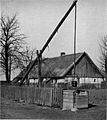Colonist House
The Prussian King Frederick II. Put with edicts and decrees population Mehrung a basis for its Frederick colonization , the creation of around 900 colonies in his Prussian sphere of influence. The king called around 60,000 settlers to his country. After the population losses caused by the Seven Years' War , Prussia should be strengthened. In Silesia there were around 992,000 people around 1740 and by 1770 the population had grown to 1,327,000 people. The recruited "colonists" built simple colonist houses in these colonies from the available regional building materials. The colonists were predominantly Bohemian - Moravian and Salzburg exiles , Dutch, Saxons, Hesse, Rhinelander and Huguenots . By 1806, 25,000 farm positions and around 400 new villages were created.
Not so popular, but not to be forgotten, there were numerous colony foundations during the Counter Reformation in the Kingdom of Saxony . It was the time when Silesia still belonged to the Habsburg Empire . The Bohemian religious refugees were allowed to found Saxon refugee colonies in which they were allowed to live their Protestant faith.
history
The war and domain administrations directed the organization of the large project to build new localities on Prussian territory. They advertised the freedom of enrollment and the social status of those interested in outdoor gardening . These had to exercise appropriate craft trades. The structure of the village, the colonist houses, the side rooms and the barns to be built were planned. Row villages were mainly designed. One of the houses was reserved for the Dorfschulzen and Kretschmann, while the colonists built smaller houses on their own and collectively. The measurements were made according to the Otetzkoian measure introduced by King Friedrich Wilhelm in 1721 . The sample drawing shown by the Silesian building director Machui from Glogau from 1776 gave the house layout for the colonist houses in Lower Silesia in the Sprottau area. This house was divided into three sections of 2.75 meters each and one section of 4.5 meters with a total length of 12.75 meters. The width of the house was 4.5 meters. The size of the living area was about 26 square meters without the kitchen.
The interior layout of the house:
- The room, which also served as a weaver's room = 11.25 square meters
- Two chambers = 6 square meters each
- Kitchen with fireplace and kettle = 6 square meters
- Hallway with stairs to the living area with pitched roof
- Stable for small livestock
- Threshing floor
- Side room with possible storage space under the roof and above the threshing floor
Colonist houses in the Prussian provinces
The colonies mentioned are a selection and not complete.
Colonist house in Potsdam-Babelsberg, formerly Nowawes
Colonist house in Hammelspring , Huguenots around 1699
Colonist house in Schönwalde (Barnim)
Colonies: Rückersdorf; 1775 Eckartswaldau; 1776 Sprottischwaldau ; 1776 Reußenfeldau; 1786 Charlottenhhal; 1775 New Forest; 1781 old forest; 1777 Schonthal; 1783 Georgenruh
Colonist house Sprottischwaldau 1777
-Formerly Saxon refugee colonies in the Queiskreis : 1663 Neu-Gebhardsdorf, 1674 Ober-Gebhardsdorf, 1710 Estherwalde , 1738 Augustthal.
Colonies: 1749 Hussinetz / Polish Gesiniec; 1750 Friedrichs-Tabor / Polish Tabor Maly; 1750 Ziska; 1764 Podiebrand / Polish Gosciecice Horny u. Dolny are created by Protestant Bohemia.
Due to the reclamation edict of the Prussian King Friedrich II of July 22, 1765 for East Friesland, colonies were built to drain the swamps and moors.
Colonist house Fehnhusen in Südbrookmerland, after 1765
Colonists also settled in Schöneberg; Schönlinde; Friedrichshagen; 1754 Rixdorf
- Lower Oderbruch : Zckerick, Gustebiese, Altwriezen, Altwustrow, Neulietzegöricke, Neulewin, Neubarnim
- Pomerania / Western Pomerania: Leopoldshagen
- East Prussia : Large Moosbruch
literature
- Theodor Fontane, Walks through the Mark Brandenburg, 1862–1889, 4. Colonization and the colonists
- David Cranz, Old and New History or Brief History of the Evangelical Brothers Unity, Volume 1, § 163, 164, 210
- Publication of the historical commission to Berlin Volume 52/1, by Otto Busch u. Wolfgang Neubauer, pages 941 to 949 (enrollment, conditions and the appointment (of the colonists))
Web links
- http://wiki-de.genealogy.net/Friderizianische_Kolonisten_1777
- http://www.riether-winkel.de/doerfer/kolonistendoerfer/
- Berlin colonist houses: https://www.stadtentwicklung.berlin.de/denkmal/liste_karte_datenbank/de/denkmaldatenbank/suchresultat.php?stichwort=Kolonistenhaus& Bezirk=&ortsteil=&strasse=&hausnummer=&denkmalart=&objekttyp=&datierung_von=&datierung_bis=&person=&objekt=
- Heading the colonists and conditions / Enrollierung: https://books.google.de/books?id=QwTnBQAAQBAJ&pg=PA942&lpg=PA942&dq=Enrollierungsfreiheit&source=bl&ots=vLDMkkOu9B&sig=Uc7622VFfPbHgVPcHX953Ia1qlI&hl=de&sa=X&ved=2ahUKEwibhK3ul5XdAhUElIsKHbA0BCUQ6AEwA3oECAcQAQ#v=onepage&q=Enrollierungsfreiheit&f=false
Individual evidence
- ^ Ulrich Niggemann: "Peuplierung" as a mercantilist instrument: privileging immigrants and state-controlled settlements . In: Jochen Oltmer (Ed.): Handbook State and Migration in Germany since the 17th Century . De Gruyter, Berlin / Boston 2016, ISBN 978-3-11-034528-5 , pp. 201 ( limited preview in Google Book search).









